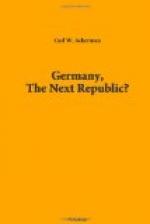In September, 1915, while the German army was moving against Russia like a surging sea, I was invited to go to the front near Vilna. During the intervening months I had observed and recorded as much as possible the growing indignation in Germany because the United States permitted the shipment of arms and ammunition to the Allies. In June I had had an interview with Secretary of State von Jagow, in which he protested against the attitude of the United States Government and said that America was not acting as neutral as Germany did during the Spanish-American war. He cited page 168 of Andrew D. White’s book in which Ambassador White said he persuaded Germany not to permit a German ship laden with ammunition and consigned for Spain to sail. I thought that if Germany had adopted such an attitude toward America, that in justice to Germany Washington should adopt the same position. After von Jagow gave me the facts in possession of the Foreign Office and after he had loaned me Mr. White’s book, I looked up the data. I found to my astonishment that Mr. White reported to the State Department that a ship of ammunition sailed from Hamburg, and that he had not protested, although the Naval Attache had requested him to do so. The statements of von Jagow and Mr. White’s in his autobiography did not agree with the facts. Germany did send ammunition to Spain, but Wilhelmstrasse was using Mr. White’s book as proof that the Krupp interests did not supply our enemy in 1898. The latter part of September I entered Kovno, the important Russian fortress, eight days after the army captured it. I was escorted, together with other foreign correspondents, from one fort to another and shown what the 42 cm. guns had destroyed. I saw 400 machine guns which were captured and 1,300 pieces of heavy artillery. The night before, at a dinner party, the officers had argued against the United States because of the shipment of supplies to Russia. They said that if the United States had not aided Russia, that country would not have been able to resist the invaders. I did not know the facts, but I accepted their statements. When I was shown the machine guns, I examined them and discovered that every one of the 400 was made at Essen or Magdeburg, Germany. Of the 1,300 pieces of artillery every cannon was made in Germany except a few English ship guns. Kovno was fortified by German artillery, not American.
A few days later I entered Vilna; this time I was moving with the advance column. At dinner that night with General von Weber, the commander of the city, the subject of American arms and ammunition was again brought up. The General said they had captured from the Russians an American machine gun. He added that they were bringing it in from Smorgon to show the Americans. When it reached us the stamp, written in English, showed that it was manufactured by Vickers Limited, England. Being unable to read English, the officer who reported the capture thought the gun was made in the United States.




